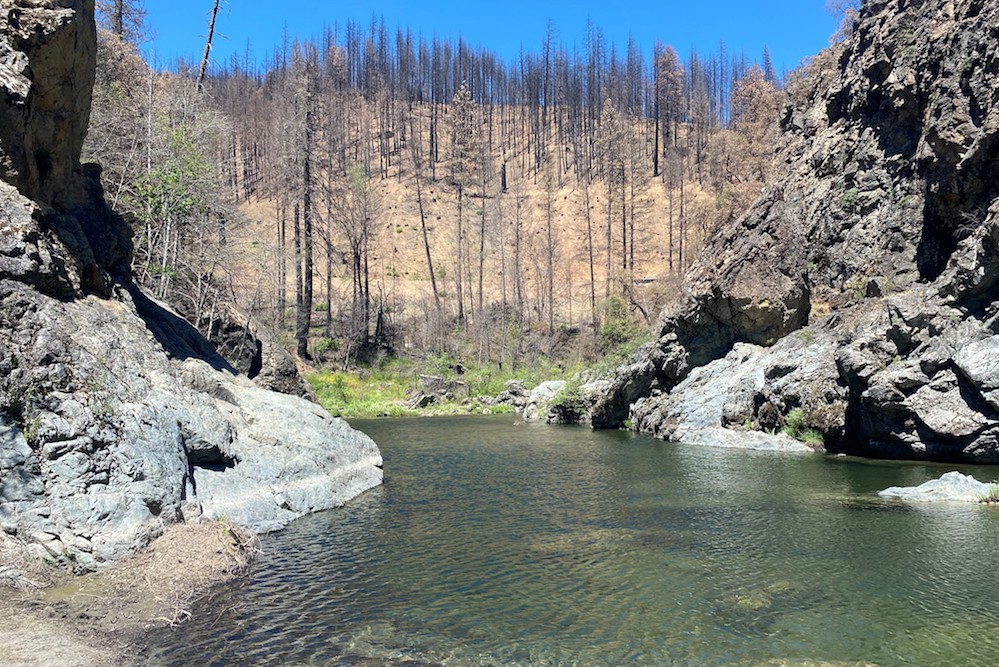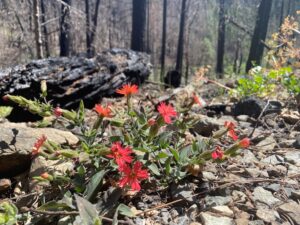
The author’s favorite hometown swimming hole, on the South Fork Trinity River in Forest Glen, California, after last year’s devastating August Complex fire. Courtesy of Lenya Quinn-Davidson.
On a recent Sunday, I lay alone by my favorite hometown swimming hole, taking in the familiar sensations of the South Fork Trinity River. The hot sun, the light up-canyon wind—sending mist over me each time it swirled past the falls—the buzz and clicking of grasshoppers, the distant sound of trucks passing by on the rural highway above. I looked down at my body and thought how remarkable it was that I’m still me, all these decades later, and the rocks and the trail and the river are still here, moving through time with steady grace. I hadn’t returned to this remote spot in years, but it still felt like home.
Beyond the river corridor, though, things were stark and unfamiliar.
In one hot, windy day last August, fire had dramatically changed this place. Flames ripped across this piece of the river canyon, killing almost every tree in their path and exposing the bare, naked soil beneath. Called the August Complex, it was the largest fire in recorded history, burning more than a million acres of forestland and woodland.
This town, Forest Glen, marked the northern edge of the blaze. It may be one of the smallest towns in California—with only 10 permanent residents—but it has always had a palpable personality, a spirit. When I drove through it that day, taking in the transformation, my eyes welled with tears over the loss. My own hometown, Hayfork, is slightly bigger and 21 miles away, but the grief has rippled out like a stone dropped in water. Mortality is heavy in hand here.
I am on the cusp of 40 years old—only 6 more months until I turn that corner. One thing they don’t tell you about turning 40 is that everyone around you starts dying around then, especially if you are lucky enough to come from a community of loving adults—your parents, their friends, the “aunties” and “uncles” who have known you since birth. One day you’re a kid and they’re looking after you, and the next day you’re 39 and a half, and they’re disappearing, one by one.
After sitting by the river that day, I wound over the mountains and dropped into the valley of my hometown—one of the two largest valleys in the Klamath Mountains, framed on all sides by signs of past fire: snag patches and dead trees, clusters of thick wildflowers, open oak woodlands and meadows, barren ridgetops. This place, my home, has so many fire stories to tell. And my stories are layered there, too, simultaneously dead and alive, just like the fire footprints that surround them.
As in many recent years, the 2020 fire season was record breaking. More than 4.2 million acres burned in California, and smoke blackened the sky, even here by the ocean. Fires burned through coastal redwood forests and scorched giant sequoias in the Sierra Nevada, testing the evolutionary adaptations that have carried some of those trees through thousands of years of fire. Recent reports from Sequoia and Kings Canyon National Parks tell us that 10 percent of the world’s mature giant sequoia trees died in last year’s Castle Fire, and that species was not the only one to suffer losses. With each severe fire season, we lose old pumpkin pines, ancient oaks, and beloved stands of mixed conifer and hardwood, in addition to the structures and other built features that also define home for us.
The loss of familiar landscapes, of specific trees or viewsheds, is the deepest kind of loss—not unlike losing a home or a family member. People are a product of place, and when we lose our sense of place, we lose our identity.
Dave Daley, a Butte County rancher, put words to this deep grief last year, after the Bear Fire burned through his mountain cattle range on the Plumas National Forest:
The fire destroyed our cattle range, our cattle, and even worse our family legacy. Someone asked my daughter if I had lost our family home. She told them “No, that would be replaceable. This is not!” I would gladly sleep in my truck for the rest of my life to have our mountains back.
I am enveloped by overwhelming sadness and grief, and then anger. I’m angry at everyone, and no one. Grieving for things lost that will never be the same. I wake myself weeping almost soundlessly…it is hard to stop.
Such losses have manifested over more than a century of mismanagement and bad politics—and maybe most importantly, an increasing disconnect between people and place.
Before European settlement in California, scientists estimate that at least 4.5 million acres burned every year across the state. That’s right—California used to see more fire every year than what we saw in last year’s “historic” fire season.
Though it’s difficult to parse out historical ignition patterns, we know that Native Californians contributed in significant ways to California’s fire regimes, actively shaping landscapes with fire to sustain their cultures and livelihoods. Some fire scientists estimate that Native Americans may have intentionally burned up to 2 million acres a year. Research from the Sierra Nevada tells us that during periods where people were most actively managing their landscapes, and using fire as a tool, climate fluctuations like drought and extreme temperatures were less likely to influence how fires burned.
However, in the early 1900s, this practice of cultural burning was criminalized when federal and state officials initiated an era of fire suppression. The stated goal was to save trees—to protect forests from the very process that had shaped and maintained them through time. Yet we know now those losses weren’t avoided; rather, by removing fire, the losses were stalled, accentuated. It’s clear that the fires that burn now are making up for generations of missed fire. The more we’ve rejected fire as the natural—and human—process that it is, the more volatile it has become.
During last year’s devastating Slater Fire, Bill Tripp, the deputy director of eco-cultural revitalization for the Karuk Tribe, wrote a powerful op-ed reflecting on his people’s connection with fire, and the federal and state policies and practices that continue to this day to threaten their ecology and culture. Just as the land was taken from the Karuk people, so too was their relationship with fire. Bill explained that Karuk people were shot for burning, even as recently as the 1930s, and he lamented the way that fire continues to be misunderstood and mismanaged:
Fire itself is sacred. It renews life. It shades rivers and cools the water’s temperature. It clears brush and makes for sufficient food for large animals. It changes the molecular structure of traditional food and fiber resources making them nutrient dense and more pliable. Fire does so much more than western science currently understands.
Dominant society has missed the mark this last century or so, trying to make static what is so naturally dynamic. We suppressed fire in the name of the trees, but we forgot about the people and the plants and the landscapes that needed fire, as vital as rain or sunshine or snow. Fire can be deadly, but at its core it’s a force of life—refreshing and renewing.
Now it’s early summer, and those of us who work in fire are bracing for yet another record-breaking season. With a backdrop of extreme heat, drought, and unusually dry vegetation, it’s hard to imagine a different outcome. Fire season feels a lot like turning 40: You’re not sure what—or who—the next loss will be, but you know it’s coming. And knowing doesn’t mean you’re ready.
In my work, I focus on bringing fire back. As a fire advisor, I work with individual landowners, tribes and cultural practitioners, community groups, and agencies to build capacity for prescribed fire—to set intentional fires that provide ecological and social benefits, reducing fire hazard but also restoring wildlife habitat and biodiversity, eradicating invasive species, and restoring landscape and community resilience. The idea is to rebuild the relationship between people and fire, and to empower the kinds of change that might bring us back into balance.

Red catchfly flowering among burnt logs in Forest Glen. Native cultures in California understood that fire renews life. This knowledge influences innovative policies that hope to harness fire to promote healthy ecosystems. Courtesy of Lenya Quinn-Davidson.
One of my biggest priorities is to foster innovation and inclusivity in fire management—to bring new, and often oppressed, perspectives and ideas to these increasingly wicked problems. Diversity begets creativity. To this end, I work with partners to create opportunities for under-represented groups in fire, with a focus on women. Much of my work in this arena is through the Women-in-Fire Training Exchange (WTREX), which is international in scope. Here in California, I also work with local communities to bring fire back as a land management tool, and to promote policies that support and elevate those efforts. I have found that people are desperate for positive connections, both with each other and with fire, and this work is the perfect venue to fill some of those gaps.
Recent years have seen an uprising around prescribed fire—a movement—as we Californians explore and reclaim our role in this fire-adapted state. Community-based burn cooperatives have sprung up across the state, providing training, resources, and inspiration for landowners, volunteer fire departments, and community members. Legislators, too, are working to tackle some of the major barriers to prescribed fire, like liability. We are seeing more commitment, both institutional and financial, by our federal and state agencies, as they try to grow and improve their prescribed fire programs. After more than a decade of working on these issues, I am more heartened than ever by the interest and momentum around prescribed fire. We’re finally seeing that we can choose to fight fire, or we can carry it with us.
When I was a kid, my dad talked about a death dream he’d had. He was falling from a cliff, but unlike most dreams where you awaken before you hit bottom, in this dream my dad actually hit the ground and died. He said it was an explosion of color, bright and warm and welcoming. It wasn’t an end, but the beginning of something different. When he died some years later, I was comforted by that story. I still think of it now, as time brings mortality increasingly into focus.
As I hiked out of Forest Glen that day, I looked across the river and saw a pool of orange in a draw behind a boulder: a thicket of wild tiger lilies. Up the trail, nestled in the blackened logs, were bright red catchflies and clusters of fresh, oily poison oak leaves. In that moment, I knew this place wasn’t dead; it was different than I knew, but it was still alive—growing, changing.
It occurred to me that our landscapes are likely closest to death when we freeze them in time—when our need for the familiar interrupts their need for process, when we inadvertently choose big losses by avoiding all the small ones. The changes in Forest Glen didn’t happen in one day last summer; rather, they’d been brewing over more than a century of fire suppression and forest management. Maybe our job now is to gain a bigger perspective—to learn to love process rather than just place. And maybe 40 is my next small fire, an opportunity to refresh and renew, to unleash new parts of myself as I let go of others. I think I’m ready.




Send A Letter To the Editors